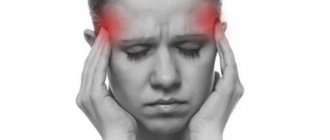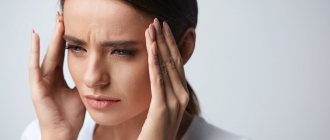A cephalologist is a neurologist who specializes in the treatment and prevention of headaches and facial pain.
Conventionally, headache is divided into primary (an independent disease) and secondary (a symptom of other diseases).
Our neurologist-cephalgologist, member of the European Headache Association Alena Konstantinovna Nepomilueva advises us on headache issues.
The pathophysiological mechanisms of the development of headaches (cephalgia) are varied:
Vascular cephalgia
Vascular cephalgia or vascular type of headaches or vasomotor cephalgia.
This mechanism is caused by vasodilation due to a systemic decrease in blood pressure or in the event of a mismatch between strong cardiac output and increased peripheral cerebral vascular resistance. A symptom of vascular type cephalgia is painful pulsations in the temples on both sides.
In case of arterial hypertension, cerebral ischemia occurs; nerve cells lack nutrients and oxygen. Here vascular cephalgia is manifested by dull pain. Patients say that they experience feelings of squeezing, aching, dizziness and floating spots before the eyes.
The second type of vascular mechanism is venous cephalgia. It is caused by vasomotor disorders of the veins and the venous blood outflow system. This develops one of two options: venous stasis or venous insufficiency.
Blood flows best through the veins when a person is standing or in an upright position. Therefore, the syndrome of vasomotor cephalgia of the venous type appears or intensifies in a lying position or sitting with the head down. A symptom of venous vascular cephalgia is headaches in the morning, accompanied by a general heaviness in the body. Often, discomfort is located in the back of the head - this is the confluence of intracranial veins. Persistent vasomotor cephalgia is eliminated by playing sports.
Tension headache
It is caused by prolonged contraction of the head muscles: chewing, occipital and scalp muscles. Tension cephalgia is based on two mechanisms:
- Psychological stress. Any mental stress, anxiety or fear activates the sympathetic part of the autonomic nervous system. It increases neuromuscular excitability, making it easier for muscles to contract.
- Segmental reflex mechanism. It works when a person sits for a long time in an uncomfortable or unnatural position.
Tension cephalgia is of moderate pain intensity. It is located symmetrically, most often in the forehead and back of the head. The nature of cephalalgia is compressive. This type of pain is also called “neurasthenic helmet”. Patients complain that they have a hard headdress placed on their head, which gradually shrinks and puts pressure on their head. When touching the head, unpleasant sensations arise. Also, any contact with the head, for example, combing hair and a strong emotional reaction causes or intensifies pain. Lasts from 30 minutes to 2-3 days.
As a disease, tension cephalalgia is diagnosed with the following criteria:
- The duration of one attack of cephalgia lasts at least 30 minutes.
- Cephalgia manifests itself specifically: “neurasthenic helmet”, compressive pain, medium in intensity, absence of pulsations.
- During physical activity, the severity of cephalgia does not increase.
Tension-type cephalgia is gradually being recognized as a separate nosology in the same way as migraine.
Liquorodynamic mechanism
Headache with this option develops as a result of a violation of the formation or outflow of cerebrospinal fluid. Intracranial hypertension syndrome develops: in the skull, due to increased fluid content, pressure increases.
Headache caused by the liquorodynamic mechanism is characterized by bursting pain. Cephalgia is also accompanied by general cerebral symptoms: dizziness, nausea and vomiting, and decreased visual accuracy. If the brain swells, the patient’s consciousness is impaired. The severity of cephalgia increases with coughing, urination, defecation and in a horizontal position. The pain decreases when the person assumes an upright position. A characteristic sign of cephalgia according to the liquorodynamic mechanism is Mann's symptom: when pressure is applied to the eyeballs during their movement, painful sensations occur.
Neuralgic cephalgia
It is characterized by short-term painful attacks, following one after another. Patients say that this pain is like shooting, like an electric shock. Trigeminal autonomic cephalgia is a type of neuralgic headache. During the examination, provoking points are identified, pressing on which causes a headache. Usually these points are localized along the trigeminal (trigeminal) nerve on the face.
Psychogenic mechanism
It is observed in depressive and hysterical individuals. The mechanism is associated with a psychogenic disorder of the nociceptive system. Cephalgia occurs due to emotional shock and worries. Chronic cephalgia often occurs due to a psychogenic mechanism.
Mixed cephalalgia
It occurs as a result of a combination of pathological mechanisms, for example, emotional stress, physical activity, arterial hypertension and lack of sleep. Cephalgia of mixed origin manifests itself depending on the dominant cause. For example, if the dominant factor is physical activity, then the clinical picture will be similar to tension-type cephalgia.
A diagnosis of “cephalgia of unknown origin” or “unspecified cephalgia” may be made when, after diagnosis, the cause has not been identified.
Migraine - What is it?
This is an attack of severe throbbing (more often) headache. Migraine has a hereditary predisposition. Women suffer from it more often (5:1 with men). Sexual predilection is caused by female hormones – a decrease in progesterone and an increase in estradiol. The mechanism is based on a violation of vascular regulation and a disturbance in the exchange of neurotransmitters.
The pathology occurs in 3 phases:
- Constriction of blood vessels and the appearance of an aura (unpleasant sensations in the body that occur before an attack of pain). An aura does not always happen.
- Dilatation of large and small vessels. The level of serotonin decreases, the level of inflammatory mediators increases. A throbbing headache occurs.
- Swelling around the vessels due to the influx of inflammatory mediators. Decreased serotonin levels.
Migraine is provoked by emotional stress, strong physical exercise, fasting and alcohol, violation of the regime, etc.
How it manifests itself:
- The duration of paroxysmal throbbing pain lasts from 4 to 72 hours, often with loss of ability to work.
- localization of pain - often on one side of the head
- cephalalgia intensifies during physical or other stress;
- one of the symptoms is present: photophobia, nausea, vomiting, sound sensitivity.
A complication of migraine is status migraine. These are attacks of severe throbbing headaches that occur one after another without a pause. Status migraine can be complicated by cerebral infarction.
Migraines don't just happen to the head. Abdominal or abdominal migraine - severe throbbing pain in the abdomen. The pain alternates: first in the stomach, then in the head, then again in the stomach. This cephalalgia occurs in children 5-10 years old. Cephalgia in a teenager is often triggered by fasting or poor nutrition.
Cluster cephalgia
It is characterized by the sudden appearance of severe, cutting and burning pain in the head. Typical localization of pain is the frontal, temporal or zygomatic areas. Even more often, histamine cephalgia is localized around one eye. Sometimes the pain spreads to the entire half of the head or face. Men get sick. The onset of the disease often occurs at the age of 30 years.
Coital cephalalgia
From Latin “coitus” is translated as “sexual intercourse”. Cephalgia occurs during sex. Occurs if intercourse is accompanied by severe emotional shock or severe physical exertion.
Orgasmic cephalalgia
Headache at the time of orgasm is caused by increased blood pressure. The physiological mechanism of orgasmic headache exactly repeats the mechanism of headache of vascular origin due to arterial hypertension.
Vertebrogenic cephalgia
Develops as a result of pathologies of the cervical segment of the spine, especially as a result of osteochondrosis.
Post-traumatic cephalgia
Post-traumatic cephalgia is headaches that appear after physical trauma to the brain or skull. It can be acute or chronic. Acute occurs within 14 days after head injury and lasts no more than 8 weeks. Chronic post-traumatic cephalgia also occurs during the first
14 days after injury, but post-traumatic persistent cephalgia continues for more than 3 months. A type is post-traumatic encephalopathy with cephalgia. It occurs due to damage to brain tissue as a result of trauma, subsequently accompanied by headaches.
Post-puncture cephalgia
Pathology occurs 5 days after dural puncture. Post-puncture cephalgia is accompanied by rigidity of the neck muscles, tinnitus, retching and photophobia.
Cerebral angiodystonia with cephalgia
Occurs against the background of organic or functional disorders of cerebral vessels. The latter arise as a result of infections, injuries or diseases of internal organs.
Cephalgia due to dyscirculatory encephalopathy
DEP with cephalgia occurs due to impaired blood supply to the brain against the background of cerebral atherosclerosis or arterial hypertension.
Cephalgia during pregnancy
Occurs against the background of toxicosis of pregnant women, against the background of eclampsia or preeclampsia. The mechanism of headaches in this case is an increase in blood pressure.
Chronic headache (cephalgia): symptoms and treatment
Cephalgia, or headache, is a nuisance that everyone has experienced at some point in their lives. This may be due to injury, overexertion, or hypertension. But the fact is that chronic cephalalgia (lasting for several days, for example) also occurs. Let's talk about this.
Symptoms
Of course, the manifestations of chronic cephalgia are countless, since there are also many ailments that constant headaches may indicate. For example, Dr. V.N. Shtok in 1987 proposed a division into the following types of chronic cephalalgia:
- Neuralgic;
- Vascular origin;
- Mixed;
- Muscle tension;
- Liquorodynamic;
- Psychalgia.
The development of medicine has made it possible to identify the following signs that you need to pay attention to first if a person experiences chronic headaches:
- Increasing power of cephalgia if you have to strain, sneeze or cough;
- Unexpected severe pain syndrome (possibly subarachnoid hemorrhage);
- Morning cephalalgia, and if nausea, vomiting and dizziness are also a sign, then we can judge the possible extensive course of the brain disease. As a rule, in this case, venous pressure may decrease;
- If a few days after the injury pain appears (subdural hematoma);
- Constant powerful cephalalgia for several hours, days, weeks may indicate a suspicion of a brain tumor, meningitis, encephalitis, but a possible illness is also chronic muscle pain, which can last more than 15 days a month or 180 days a year;
- If pain sensations that appear at night contribute to awakening from sleep (migraine, cluster headache).
Diagnostics
Diagnostics must be carried out by specialists in order to identify the ailment that torments the patient. The following methods are used for this:
- EchoEG (using this method, dilation of the ventricles in the brain is usually diagnosed);
- EEG (if there is a suspicion of migraine cephalgia);
- study of cerebral hemodynamics (blood circulation, blood vessels are diagnosed, signs of venous cephalgia can be seen);
- MRI, CT (to exclude tumors in the brain).
Therapy
Today there are 2 methods of therapy. The first involves prevention, the second - relieving the symptoms of a sudden attack (usually used in the treatment of migraines).
Preventive treatment consists of reducing the frequency, duration and severity of pain. This includes, depending on the pathology, types of therapy such as:
- Botulinum toxin (Botox injections);
- Antiepileptic drugs (Topiramate Gabapentin, Valproate);
- Venotonic drugs;
- Calcium antagonists;
- Ergotamine preparations;
- Cavinton cerebrovascular accident corrector;
- Sedatives (valerian, motherwort, mint, barbiturates);
- Antidepressants (Fluoxetine Amitriptyline);
- Central muscle relaxants (Mydocalm, Tizanidine);
- Non-steroidal anti-inflammatory drugs (Aspirin, Ibuprofen, Diclofenac);
- Etc.
An important clarification: medications are not a guide to action, since certain medications are used in different cases. For venous pain, it is unacceptable to use calcium antagonists, and for vasomotor pain, venotonics. This should be taken into account. Treatment is prescribed by a doctor based on the diagnosis.
With the development of botulinum therapy, the effectiveness of botulinum toxin for chronic migraine has been proven. In the USA, operations have already been performed with Botox injection and removal of the trigeminal nerve, after which the patient’s migraine disappeared.
In addition, massage, physical therapy, and psychological therapy methods will be used.
Psychotherapy is effective if the patient has a disease that accompanies the disease, and also if the patient does not respond to drug treatment. Author: K.M.N., Academician of the Russian Academy of Medical Sciences M.A. Bobyr
What is a cluster headache?
Headache, or cephalgia, is a common companion in life in both adults and children. It turns out that experts distinguish several types of cephalgia, differing from each other both in the causes of occurrence and in the tactics of getting rid of it. Daria Vasilievna Kunitsyna, a neurologist at Clinic Expert Stavropol, told us about one of them – cluster headaches, the peculiarities of its manifestation, diagnostic methods and treatment methods.
- Daria Vasilievna, what does “cluster headache” mean?
Cluster headache (or, otherwise, cluster headache) is a type of headache of a paroxysmal nature with a pronounced pain syndrome of clear localization. With cluster cephalgia, a person experiences repeated attacks of intense throbbing pain in the eye sockets, periorbital region and temples.
This is a fairly rare pathology, affecting approximately 5% of the entire population.
-What are the causes of cluster headache?
Typically, the cause of this type of headache is a violation of circadian rhythms - cyclical fluctuations in the intensity of various biological processes in the body, which are caused by the change of day and night. A special anatomical structure in the brain - the hypothalamus - is responsible for the continuity of these rhythms.
Pathologies of the hypothalamic-pituitary system, damage to the reticular formation, spasm of cerebral vessels, diseases of the sympathetic nervous system can provoke the development of cluster headaches.
Cluster headaches are more common in men (20 to 50 years of age) than women (5:1 ratio) and in overweight individuals
- Are there risk groups that are more susceptible to this pathology?
Eat. Cluster headaches occur more often in people who:
— are exposed to frequent changes in time zones (due to moving, traveling);
— violate the work and rest schedule;
- abuse alcohol and smoking;
- use certain medications - in particular, nitroglycerin and histamine.
I would like to note the fact that this pathology is more common in men (from 20 to 50 years old) than in women (in a ratio of 5:1), as well as in overweight individuals.
Read materials on the topic:
Isn't it beer that kills people? Alcohol and the brain
What does fat have to do with it or why do people gain weight?
-What characteristic symptoms can be used to recognize a cluster headache?
The peculiarity of this type of cephalgia is its sudden occurrence against the background of complete health, often at night, during sleep. The pain is clearly localized on one side of the head. Patients describe this pain as “unbearable, burning, throbbing.” During attacks, the patient freezes, as the slightest movements cause him severe pain.
Upon examination, you may note redness of the face due to dilated blood vessels, lacrimation, and increased salivation.
- Do children have cluster headaches? If so, how do they manifest themselves?
They happen, but extremely rarely. To differentiate it from other types of cephalgia that develop against the background of increased temperature in various diseases and intoxication of the body, a specialist should pay attention to the sudden onset of headache in the absence of other symptoms, its clear location (orbits, periorbital and temporal areas) and the nature of the sensations. Children describe this pain as “drilling.”
- How is cluster headache diagnosed?
First of all, we clarify the complaints and find out how the disease developed. In this case, attention should be paid to complaints of unilateral damage, characteristic areas of pain, attacks of high intensity pain that occur three to eight times during the day.
After this, a number of laboratory and instrumental research methods are prescribed. Traditional laboratory methods include a general blood test to exclude an inflammatory process, a coagulogram to determine blood clotting and exclude thrombus formation in the vessels of the brain, and a biochemical blood test to assess the concomitant pathology of internal organs.
Read more about blood tests in our articles:
How to properly take a general blood test?
What does a biochemical blood test show?
To visualize brain structures, magnetic resonance or computed tomography may be prescribed to exclude focal lesions, as well as MR angiography or Doppler ultrasound of the cerebral arteries to detect acute cerebrovascular accidents, hemorrhages, or blockage of blood vessels by blood clots.
Read materials on the topic:
If an MRI of the brain showed...
How will MRI of cerebral vessels help a patient?
When is ultrasound of cerebral vessels prescribed?
Consultations with related specialists may also be required - for example, an ophthalmologist who can conduct a fundus examination and measure intraocular pressure. You should consult a therapist to exclude somatic pathology, and a psychotherapist to differentiate cluster headaches from cephalgia in mental pathologies.
- Tell us how to get rid of cluster headaches?
There are two directions in the treatment of cluster headaches. Symptomatic treatment is aimed at eliminating the pain syndrome, and preventive treatment is aimed at reducing the frequency of subsequent exacerbations. Non-drug methods include oxygen inhalation.
As therapy, drugs from the ergotamine group are also prescribed to strengthen the vascular wall. For prolonged periods, hormonal therapy, antipsychotics, tranquilizers, and antidepressants are used. It is important to note that self-medication is inappropriate here, and any medications should be taken under the strict supervision of a doctor.
Unfortunately, it is currently impossible to completely cure this disease, but with supportive treatment, lasting positive results can be achieved.
-What are the dangers of cluster headache attacks?
High intensity of pain leads to asthenia (weakening) of the patient. Attacks and their anticipation can lead to the development of depressive and anxiety disorders. There are known cases of suicide attempts due to unbearable pain. Another danger is long-term use of medications to get rid of cluster cephalgia, which can harm other organs.
- Daria Vasilyevna, is it possible to prevent the development of this pain? If so, how?
Maintaining a healthy lifestyle, giving up bad habits, following a work-rest schedule, playing sports, walking, a balanced diet, reducing the number of stressful situations - these simple rules will help reduce the frequency of cluster headache attacks.
The editors recommend:
Medical horror stories. Myths and truth about migraines
Tension headache: causes, symptoms, diagnosis and treatment
Attack to the head. How to protect yourself from summer meningitis?
When the brain is inflamed: what is encephalitis?
MRI of the brain for prevention
For reference:
Kunitsyna Daria Vasilievna
In 2014 she graduated from Stavropol State Medical University with a degree in General Medicine.
In 2021, she completed her residency training in the specialty “Neurology” at the City Clinical Emergency Hospital of Stavropol.
Neurologist at the Expert Clinic, Stavropol. Receives at the address: st. Dovatortsev, 39A










